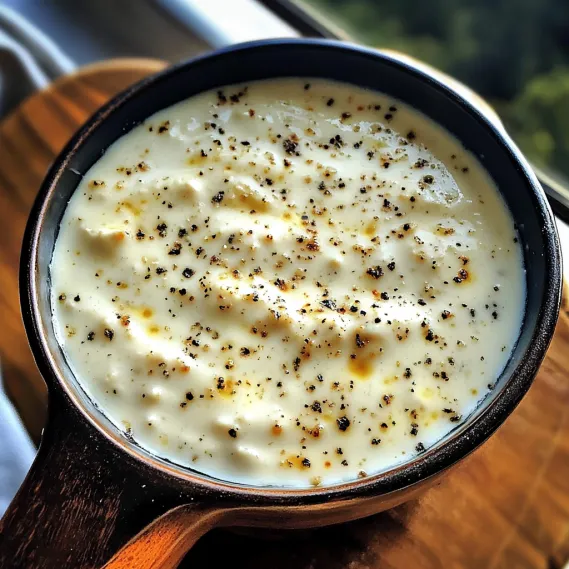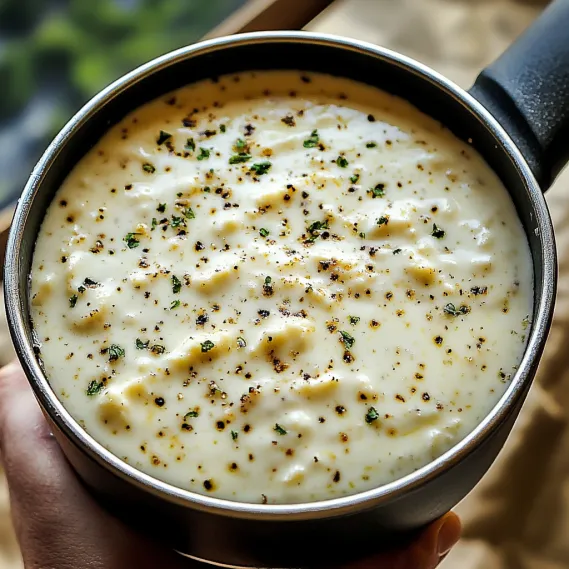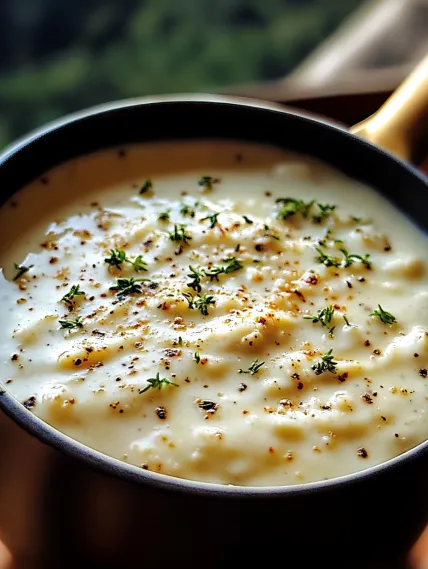 Pin it
Pin it
This garlic white sauce transforms ordinary pizza into a restaurant-quality white pizza experience with minimal effort. The creamy, savory base pairs perfectly with any toppings and elevates homemade pizza night to something truly special.
I first created this sauce when my Italian grandmother visited and was horrified by my store-bought pizza sauce. Her impromptu cooking lesson became our family's most treasured recipe, and now my kids request "Nonna's white pizza" at least twice a month.
Ingredients
- Unsalted butter: Creates the rich base of the sauce and allows you to control the salt level
- Fresh garlic cloves: Provide that unmistakable aromatic flavor that dried versions simply cannot match
- All-purpose flour: Acts as the thickening agent for perfect consistency every time
- Black pepper: Adds a subtle heat that balances the creaminess
- Salt: Enhances all the other flavors and brings everything together
- Dried oregano: Introduces a classic Italian herb note that perfectly complements pizza
- Full-fat milk: Creates the silky texture that makes this sauce special avoid low-fat versions which can make the sauce watery
- Freshly grated Parmesan cheese: Not the pre-grated kind delivers the authentic nutty flavor that makes this sauce irresistible
How To Make Garlic White Sauce
- Butter Melting:
- Place a small saucepan over medium heat and add your unsalted butter. Allow it to melt completely until it becomes liquid but watch carefully to prevent browning. The butter should look clear and golden, not dark.
- Garlic Infusion:
- Add your finely chopped fresh garlic to the melted butter. Stir continuously for approximately 30 seconds. You want to release the garlic flavor into the butter but stop cooking before it turns brown or bitter. The garlic should become fragrant and slightly translucent.
- Creating the Roux:
- Sprinkle your flour, black pepper, salt, and dried oregano into the pan with the garlic butter. Whisk continuously and vigorously to create a smooth paste without any lumps. Continue cooking this mixture for 1-2 minutes to cook out the raw flour taste. The roux should look slightly golden and smell nutty.
- Developing the Sauce:
- Pour the milk into your roux very gradually, starting with just a few tablespoons while whisking constantly. Once that initial milk is incorporated, you can add the remainder in a slow stream, always whisking. Continue stirring until the sauce thickens enough to coat the back of a spoon, usually about 3-5 minutes.
- Cheese Integration:
- Remove the pan from heat completely before adding your freshly grated Parmesan. Stir until the cheese fully melts and incorporates, creating a smooth, velvety texture. The sauce should be thick enough to spread but still flowing slightly.
- Immediate Application:
- Use the sauce right away while warm and pliable for the best spreading consistency on pizza dough. If making ahead, transfer to a container, press plastic wrap directly onto the surface to prevent skin formation, and refrigerate.
 Pin it
Pin it
My absolute favorite way to enjoy this sauce is on a thin-crust pizza topped with roasted mushrooms and fresh arugula added after baking. This combination reminds me of the white pizzas my grandmother would make for special Sunday dinners, when the whole family would gather around her tiny kitchen table.
Storage Recommendations
This garlic white sauce keeps beautifully in the refrigerator for up to 5 days when stored in an airtight container. The sauce will solidify when cold, so to revive it, warm gently in a saucepan over low heat, adding a splash of milk if needed to restore the creamy consistency. Stir frequently while reheating to prevent scorching. I do not recommend freezing this sauce as the dairy components tend to separate upon thawing, resulting in a grainy texture that no amount of reheating can fix.
 Pin it
Pin it
Creative Uses Beyond Pizza
While this sauce was born as a pizza base, its versatility extends far beyond that initial purpose. Try tossing it with freshly cooked fettuccine for a quick weeknight pasta dinner. It also makes an incredible dipping sauce for breadsticks, garlic knots, or even roasted vegetables. One of my favorite discoveries was using it as a base layer in a white lasagna with spinach and mushrooms. For an elegant appetizer, spread it on crostini and top with sautéed wild mushrooms or roasted cherry tomatoes. The rich garlic flavor complements so many dishes that I often make a double batch just to have on hand for impromptu cooking inspiration.
Customization Options
The beauty of this base recipe lies in its adaptability to various flavor profiles. For a hint of heat, add a pinch of red pepper flakes along with the dried oregano. Seeking an herbaceous variation? Stir in a tablespoon of fresh chopped basil or parsley just before serving. Replace a quarter of the Parmesan with crumbled gorgonzola for a more complex cheese flavor. For a luxurious special occasion version, substitute half the milk with heavy cream. Love roasted garlic? Replace the fresh garlic with an equal amount of roasted garlic for a sweeter, more mellow flavor profile. Each variation creates a slightly different sauce while maintaining the creamy, garlic-forward base that makes this recipe so beloved.
Frequently Asked Questions
- → Can I make this sauce ahead?
Yes, you can prepare the sauce ahead of time. Let it cool completely and store it in an airtight container in the refrigerator for up to 3 days. Reheat gently on low heat while stirring.
- → What can I use this sauce for?
This sauce is perfect for pizza, pasta, or even as a dip for breadsticks. Its creamy texture and garlic-Parmesan flavor complement a variety of dishes.
- → Can I use non-dairy milk for this recipe?
Yes, you can substitute the full-fat milk with unsweetened non-dairy milk, such as almond or oat milk. However, the texture and flavor might slightly vary.
- → How do I prevent the sauce from getting lumpy?
To avoid lumps, whisk constantly while slowly adding the milk to the roux. Ensure the milk is at room temperature for smoother incorporation.
- → Can I add other spices or herbs?
Absolutely! While oregano and black pepper are classic, you can experiment with thyme, basil, or even a pinch of chili flakes for a spicy twist.
